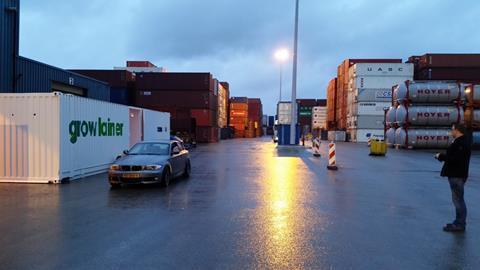
Where do you see the potential for Growtainers in the salads sector?
Glenn Behrman: We have found that LED-lit, climate-controlled vertical farming is perfect for the production of herbs and leafy greens. Products can even be grown in a supermarket parking lot. Just a few of the advantages of this type of production are that products are much fresher, there is more control, no pesticides and more opportunity to produce smaller quantities of gourmet and ethnic products.
Who is currently using them in the UK?
GB: This portable high-tech indoor farm left our Rotterdam facility for a well-known UK grower last week – our first UK customer. This is the first unit of its kind built and sold in Europe. There are operating units in the USA in Dallas, Texas and New York City. We already have orders for other major European cities, both for research and production.
How do they compare to existing growing systems?
GB: Nothing will ever replace the traditional field grower or greenhouse grower, at least not in our lifetimes, but this is the beginning of technology-based production. I believe that this will encourage more young people to get involved with farming, I believe that it will motivate and inspire people to further creativity and research in agriculture. I think that Controlled Environment Agriculture is still in its infancy but it’s catching on very quickly. When I first started getting involved with this (after 40 years in horticulture) it was science fiction, but now it’s ready to become mainstream.
How much does a Growtainer cost and what facilities does it come with?
GB: A Growtainer costs between $90,000 (£62,000) and $100,000 (£70,000) and can be delivered to most of Europe. Each unit comes equipped with the appropriate LED lighting, climate and environmental controls, a complete irrigation system including monitoring and dosing and a specially designed Growrack system with from 30 to 50 growing levels (depending on the crop).
How big is the Growtainer and how much could it produce of atypical baby leaf line, for example?
GB: Each grower is different and I don’t like to make production representations. But each Growtainer can hold between 180 and 250 standard 10” by 20” grower trays. Take micro-greens – using that scenario a grower can produce 250 trays every 10-14 days. Growtainers are stackable and can be modified in many different configurations. The idea of a Growtainer farm is very appealing since they only require a very small footprint.
What else should a grower know about Growtainers?
GB: I think the two most important things that I’m working on are a series of crop-specific Growtainers and a significant amount of research in Controlled Environment Production. I’m very curious about the power of CEA. Not everything is profitable in a controlled environment for one reason or another so what we are doing is developing a Growtainer that is based on a profitable business case. We know what crops have the highest profit potential in this high-tech environment so we’re designing and building Growtainers that are perfect for those crops.



